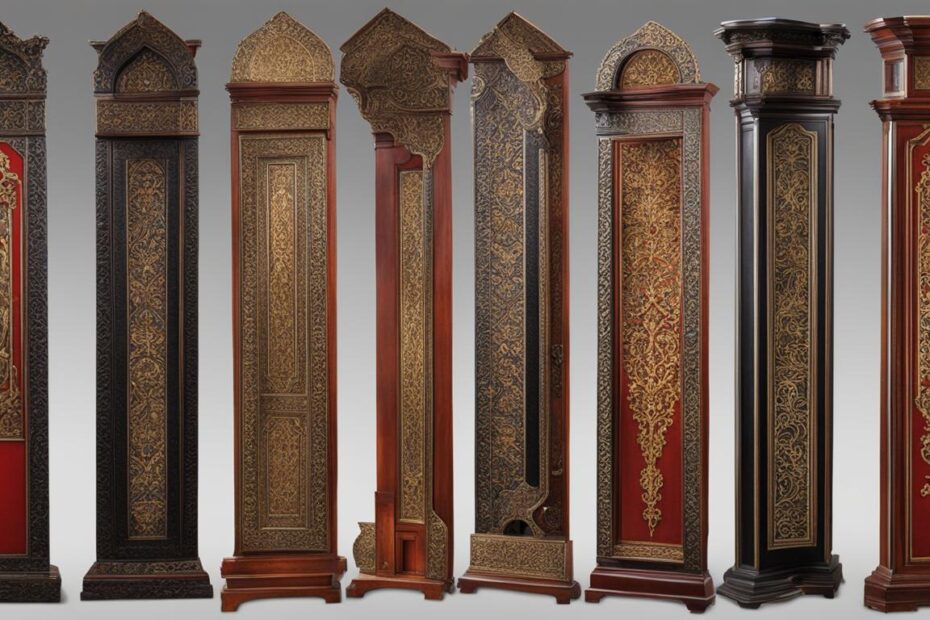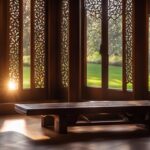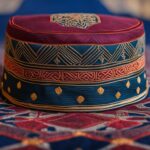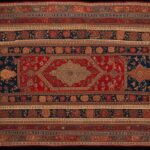The history of prayer kneelers is a fascinating tapestry of tradition, faith, and craftsmanship. These unique devotional tools have evolved over centuries, from humble homemade designs to intricate pieces found in cathedrals and churches. Let us delve into the rich history of prayer kneelers and discover the significance they hold in religious practices.
Key Takeaways:
- Prayer kneelers have a long and storied history, dating back to the 17th century.
- They serve as a tangible connection to our heritage and offer insight into past social history.
- Prayer kneelers symbolize humility and reverence in Christian worship.
- Various materials are used in crafting prayer kneelers, including wood, metal, and upholstery.
- There are other lesser-known prayer tools, such as the kippah and tefillin, that enhance the prayer experience.
The Origins of Prayer Kneelers
The history of prayer kneelers dates back to the 17th century when the technique of “Turkey work” knotting emerged as a popular method for crafting these devotional tools. However, it was the development of “Berlin work” in the following centuries that truly revolutionized the design and decorative possibilities of prayer kneelers. This technique allowed for intricate needlework, incorporating a variety of patterns and motifs.
It wasn’t until 1915 that the invention of Rexine, an artificial leather substitute, provided a durable and versatile material for prayer kneelers. This breakthrough laid the foundation for the modern-day production of these devotional tools. Rexine offered a more practical alternative to the traditional use of cloth and enabled craftsmen to create prayer kneelers that were both aesthetically pleasing and long-lasting.
In the early 20th century, the practice of using canvaswork to decorate ecclesiastical cushions gained popularity. The chapel in the Bishop’s Palace, Winchester, became the first known example of such decoration in 1931. From there, the tradition of creating hassocks and seat cushions adorned with intricate designs spread to cathedrals and churches, further enhancing the visual appeal of prayer kneelers.
“The development of prayer kneelers showcases the evolution of needlework techniques and the ingenious use of materials over the centuries.”
The Evolution of Prayer Kneeler Design
Throughout history, prayer kneeler designs have evolved, reflecting changes in artistic styles and religious practices. Traditional prayer kneelers were often characterized by intricate carvings and decorative details, showcasing the craftsmanship of skilled artisans. As time went on, the emphasis shifted towards functionality and comfort, with prayer kneelers being designed to provide a supportive and comfortable kneeling experience.
Modern prayer kneelers also incorporate ergonomic considerations, ensuring individuals can engage in prayerful reflection for extended periods without discomfort. Various materials, including wood, metal, and upholstery, are now used in their construction. Wood offers a timeless elegance, while metal provides a sleek and contemporary aesthetic. Upholstered prayer kneelers feature cushioning that enhances comfort and reduces strain on the knees.
Despite these design changes, the essence of prayer kneelers as tools for meaningful prayer and spiritual connection has remained steadfast. They continue to play a significant role in religious worship, providing individuals with a dedicated space for prayer and reflection.
| Material | Advantages | Disadvantages |
|---|---|---|
| Wood | Timeless elegance, sturdy | May require periodic maintenance |
| Metal | Sleek and modern aesthetic | May be less comfortable for prolonged use |
| Upholstery | Comfortable cushioning | Requires cleaning and upkeep |
Prayer kneelers have come a long way from their humble origins to the beautifully crafted and functional pieces we see today. The evolution of prayer kneeler design reflects both the artistic and practical considerations of each era, while the materials used continue to offer a balance between aesthetic appeal and comfort. The significance of these devotional tools extends beyond their physical attributes, serving as a testament to the enduring importance of prayer in our lives.
The Significance of Prayer Kneelers
Prayer kneelers hold great historical significance as they serve as a rich and vivid record of the social history of past decades. These pieces of folk art often depict local wildlife, historical buildings, and favorite Bible stories. They are a testament to the creativity and craftsmanship of generations past, capturing the spirit of their time. Antique prayer kneelers, in particular, offer a glimpse into the past and provide a valuable link to our heritage.
The Historical Significance of Prayer Kneelers
Antique prayer kneelers not only showcase the artistic talents of their creators but also provide insights into the historical contexts in which they were made. These intricately designed pieces offer a unique perspective on the cultural and religious practices of the time. They reflect the values, beliefs, and traditions of the communities in which they were used. By examining antique prayer kneelers, researchers and enthusiasts can gain a deeper understanding of the social, religious, and artistic aspects of different periods in history.
Moreover, prayer kneelers serve as tangible connections to our ancestors and the devotional practices they cherished. As we admire and preserve these artifacts, we honor the faith and spirituality of those who came before us. The historical significance of prayer kneelers lies not only in their material value but also in their ability to evoke a sense of reverence and nostalgia for a bygone era.
“Antique prayer kneelers offer a glimpse into the past and provide a valuable link to our heritage.”
Preserving Our Heritage
Preservation efforts for antique prayer kneelers are crucial for ensuring that future generations can appreciate and learn from these historical treasures. Museums, collectors, and religious institutions play a vital role in safeguarding these artifacts, maintaining their original condition, and showcasing their beauty and historical significance to the public.
By recognizing the significance of prayer kneelers and their historical context, we can foster an appreciation for the craftsmanship, artistry, and cultural traditions that they represent. Through education and awareness, we can inspire others to value and protect these unique pieces of our shared heritage.
| Benefits of Preserving Antique Prayer Kneelers | Importance of Historical Significance |
|---|---|
| – Offers insights into social and religious practices | – Connects us to the past and our ancestors |
| – Provides a visual record of cultural traditions | – Stimulates nostalgia and reverence |
| – Enhances historical research and understanding | – Contributes to the preservation of our heritage |
The Evolution of Prayer Kneeler Design
The designs of prayer kneelers have evolved over time, reflecting changes in artistic styles and religious practices. Traditional prayer kneelers were often intricately carved and adorned with elaborate decorations, showcasing the exquisite craftsmanship of artisans. These designs featured intricate patterns, religious symbols, and scenes from biblical stories. The emphasis was on creating visually stunning pieces that enhanced the devotional experience.
In more recent times, prayer kneeler design has shifted towards functionality and comfort. The focus is on creating kneelers that provide optimal support for individuals during extended periods of prayer. Modern prayer kneelers often feature ergonomic designs with padded cushions to alleviate strain on the knees and ensure a more comfortable prayer experience. The materials used have also evolved, with the incorporation of lightweight metals and durable upholstery fabrics.
Additionally, prayer kneelers have become more versatile in their design, catering to different worship spaces and individual preferences. Adjustable kneelers allow users to customize the height and angle to suit their comfort. Some designs even incorporate storage compartments for personal items or additional seating options. These innovations demonstrate the adaptability of prayer kneelers in meeting the evolving needs of worshippers.
“The designs of prayer kneelers have evolved over time, reflecting changes in artistic styles and religious practices.”
The Evolution of Prayer Kneeler Design
The evolution of prayer kneeler design can be observed through the centuries, with each era leaving its mark on the aesthetics and functionality of these devotional tools. From ornate and highly decorative designs to ergonomic and customizable options, prayer kneelers continue to evolve to enhance the prayer experience for individuals of different backgrounds and traditions.
| Time Period | Design Characteristics |
|---|---|
| Medieval Era | Intricate carvings, religious symbols |
| Renaissance | Ornate decorations, scenes from biblical stories |
| Modern Era | Ergonomic design, padded cushions |
| Contemporary | Adjustable height and angle, storage compartments |
The Role of Prayer Kneelers in Worship
Prayer kneelers, also known as prie-dieu, have a long and significant history in Christian worship. These devotional tools provide a dedicated space for individuals to kneel and engage in prayerful reflection. Symbolizing humility and reverence, prayer kneelers serve as a physical representation of one’s submission and respect towards the divine presence.
Throughout history, prayer kneelers have played a central role in creating a focused and reverent prayer experience. By kneeling on a prayer kneeler, individuals are able to physically lower themselves, signifying their willingness to submit to God’s will and seek spiritual connection. This act of humility and reverence enhances the prayer experience and helps individuals to enter a state of deep reflection and communion with the divine.
Historically, prayer kneelers were commonly found in cathedrals and churches, where they were utilized during services and private devotions. They provided a designated space for worshippers to kneel, offering comfort and support during extended periods of prayer. The use of prayer kneelers helped to create an atmosphere of reverence and solemnity, aiding individuals in focusing their minds and hearts on their spiritual practice.
| Historical Uses of Prayer Benches | Descriptions |
|---|---|
| During Mass | Prayer kneelers were commonly used during Mass, providing a space for individuals to kneel during prayer and worship. |
| Private Devotions | Prayer kneelers allowed individuals to have a dedicated space for their private devotions, providing a physical reminder of the sacredness of their prayers. |
| Penitential Practices | In some traditions, prayer kneelers were used during penitential practices, emphasizing the act of humility and seeking forgiveness. |
| Liturgical Ceremonies | Prayer kneelers were often incorporated into liturgical ceremonies, such as weddings and ordinations, symbolizing the commitment and reverence associated with these sacred events. |
Today, prayer kneelers continue to be an integral part of worship in many Christian traditions. While their designs and materials may vary, their purpose remains the same – to provide a physical space for individuals to humble themselves before God and engage in prayerful reflection. Whether in a grand cathedral or a small chapel, the presence of a prayer kneeler serves as a reminder of the enduring value of reverence and devotion in our spiritual lives.
The Materials Used in Prayer Kneelers
Prayer kneelers are crafted using various materials to suit different preferences and needs. The choice of material plays a significant role in not only the aesthetic appeal but also the functionality and comfort of the prayer kneeler. Let’s explore some of the commonly used materials for prayer kneelers.
Wood
Wood is a popular choice for prayer kneelers due to its timeless elegance and durability. Different types of wood, such as oak, cherry, and walnut, are used to create prayer kneelers with varying finishes. Wood offers a warm and inviting look, and it can be carved and embellished with intricate designs to add a touch of craftsmanship.
Metal
Metal prayer kneelers provide a sleek and modern aesthetic. Materials like stainless steel and aluminum are commonly used for their strength and durability. Metal kneelers can be designed in a minimalist style, focusing on clean lines and functionality. They are often lightweight and portable, making them convenient for use in different settings.
Upholstery
Upholstered prayer kneelers feature comfortable cushioning that enables individuals to engage in prolonged prayer without discomfort. The cushioning can be made of various materials such as foam, memory foam, or polyester fiberfill. The upholstery fabric adds a layer of softness and can be chosen to match the overall decor of the space. Common upholstery materials include velvet, microfiber, and faux leather.
| Material | Characteristics |
|---|---|
| Wood | Timeless elegance, durability, intricate designs |
| Metal | Sleek and modern aesthetic, strength, portability |
| Upholstery | Comfortable cushioning, choice of fabric |
When selecting a prayer kneeler, it’s important to consider the materials used and their suitability for your preferences and the intended use of the kneeler. Whether you prefer the classic beauty of wood, the contemporary appeal of metal, or the comfort of upholstered cushioning, there is a prayer kneeler material that will meet your needs and enhance your prayer experience.
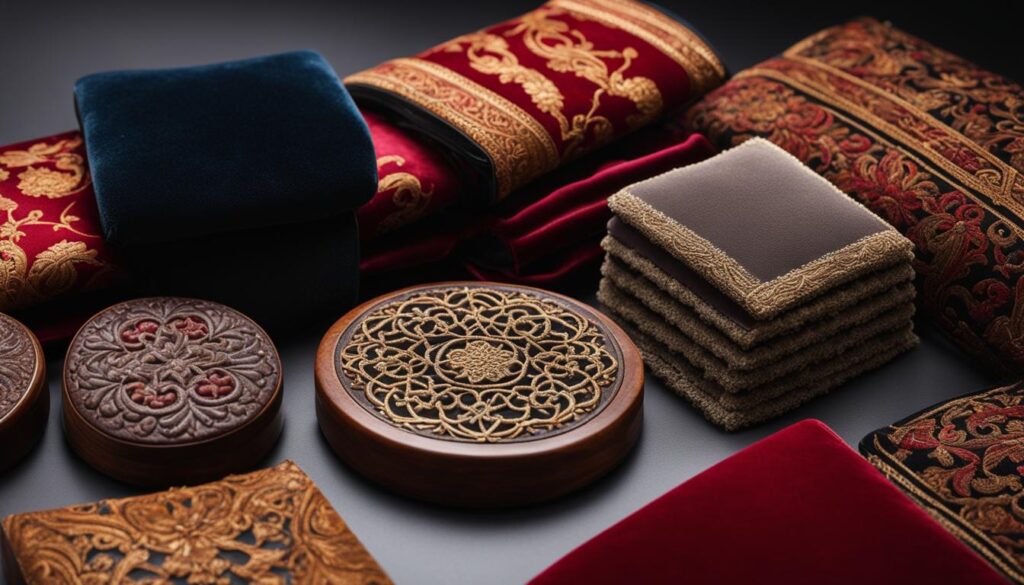
Lesser-Known Prayer Tools
While prayer kneelers are a widely recognized devotional tool, there are other lesser-known prayer tools that hold their own unique significance in various religious customs. These tools enhance the prayer experience and offer individuals additional ways to connect with their faith. Two such tools are the kippah and tefillin.
The Kippah (Yarmulke)
The kippah, also known as a yarmulke, is a small cap traditionally worn by Jewish men as a sign of reverence and humility before God. It serves as a constant reminder of the presence of the divine and the need for spiritual connection. The kippah is typically made of fabric, such as satin, velvet, or crocheted yarn, and is worn on the top of the head. It is customary for Jewish men to wear a kippah during prayer, as well as during other religious and ceremonial occasions.
Tefillin (Phylacteries)
Tefillin, or phylacteries, are small black leather boxes containing verses from the Torah that are worn during morning prayers. They serve as a physical representation of one’s dedication to the commandments and the study of God’s word. Tefillin consist of two boxes, one for the arm and one for the head, both of which are bound with leather straps. The arm tefillin is placed on the non-dominant arm, while the head tefillin is positioned above the hairline. The act of binding the tefillin is a ritual in itself, with specific prayers recited during the process.
Both the kippah and tefillin hold deep spiritual significance in their respective religious traditions. They serve as visual reminders of one’s commitment to faith and offer a tangible way to engage in prayerful reflection. While lesser-known compared to prayer kneelers, these prayer tools play an essential role in the religious practices of many individuals.
| Prayer Tool | Significance |
|---|---|
| Kippah (Yarmulke) | A sign of reverence and humility before God. Represents constant awareness of the divine presence. |
| Tefillin (Phylacteries) | Contains verses from the Torah. Represents dedication to the commandments and the study of God’s word. |
Conclusion
The rich history of prayer kneelers is a testament to the enduring traditions and deep spirituality surrounding these devotional tools. From their origins in homemade designs to their ornate presence in cathedrals and churches, prayer kneelers have provided a sacred space for individuals to engage in prayerful reflection for centuries.
With their intricate craftsmanship and historical significance, prayer kneelers offer a window into the past, allowing us to connect with our heritage and appreciate the artistry of generations gone by. These pieces of folk art, adorned with depictions of local wildlife, historical buildings, and beloved Bible stories, serve as a tangible representation of faith and devotion.
As we continue to value the prayer kneeler history, it is important to preserve and honor these unique devotional tools for future generations. By doing so, we ensure that the tradition and reverence associated with prayer kneelers remain intact, providing a meaningful prayer experience for all who seek solace and connection with the divine.
FAQ
What is the history of prayer kneelers?
The history of prayer kneelers dates back to the 17th century and has evolved over time, reflecting changes in artistic styles and religious practices.
How were prayer kneelers originally made?
Prayer kneelers were originally homemade, adorned with local wildlife and historical references. Techniques such as “Turkey work” and “Berlin work” were used to create decorative needlework.
What is the significance of antique prayer kneelers?
Antique prayer kneelers offer a glimpse into the past and serve as a valuable link to our heritage. They provide a rich record of social history and showcase the creativity and craftsmanship of past generations.
How have prayer kneeler designs evolved?
Prayer kneeler designs have evolved over time, reflecting changes in artistic styles and religious practices. Traditional designs were often intricately carved and decorated, while modern designs prioritize functionality and comfort.
What is the role of prayer kneelers in worship?
Prayer kneelers, also known as prie-dieu, play a central role in Christian worship. They provide a dedicated space for individuals to kneel and engage in prayerful reflection, symbolizing humility and reverence.
What materials are used to make prayer kneelers?
Prayer kneelers are crafted using materials such as wood, metal, and upholstery. Wood offers timeless elegance and sturdiness, while metal provides a sleek and modern aesthetic. Upholstered kneelers feature comfortable cushioning.
Are there any other lesser-known prayer tools?
Yes, there are other lesser-known prayer tools such as the kippah (yarmulke) worn by Jewish men as a sign of reverence, and tefillin (phylacteries) containing verses from the Torah that are worn during morning prayers.
Why is it important to preserve prayer kneelers?
Preserving prayer kneelers is important because they hold historical and cultural significance. They provide a tangible link to our past and serve as a reminder of the devotion, craftsmanship, and reverence in religious practices.


